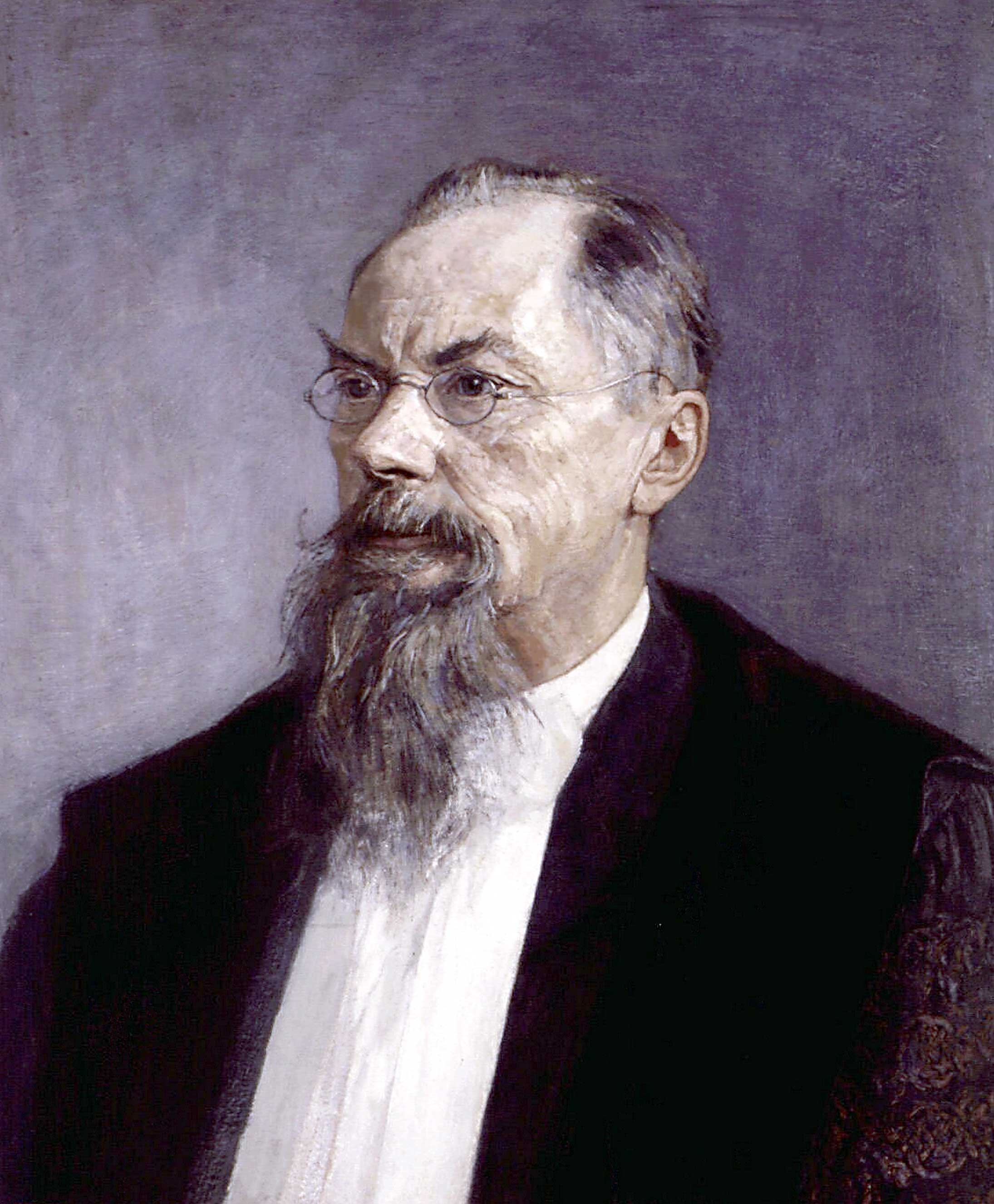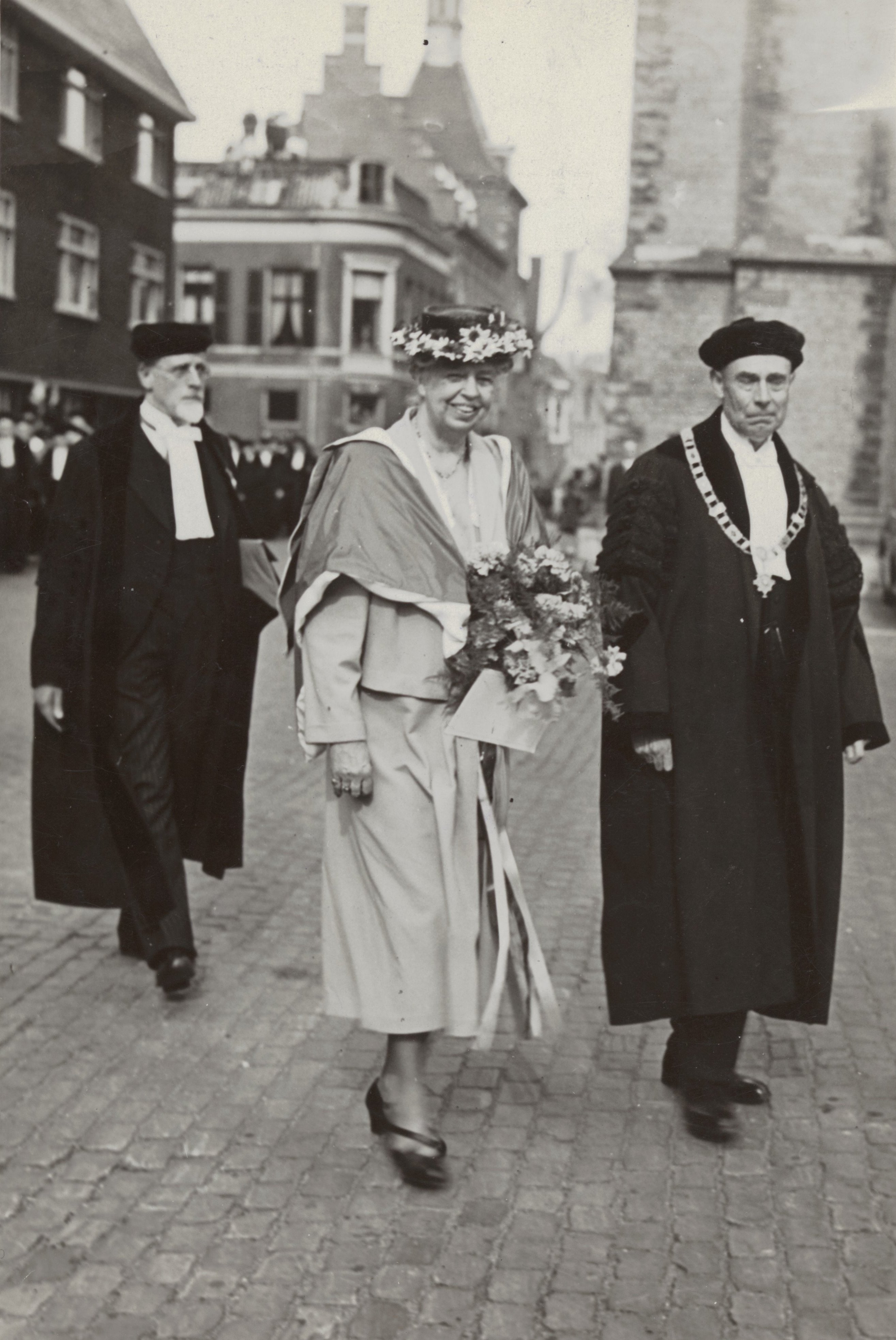|
Cornelis Adrianus Pekelharing
Cornelis Adrianus Pekelharing (19 July 1848 – 18 September 1922) was a Dutch physiologist who worked extensively on problems relating to nutrition and human metabolism. Pekelharing was born in Zaandam, the sixth child of physician Cornelis and his wife Johanna van Ree. His early studies were in schools at Zaandam. Following the family tradition, he was admitted to study medicine at the University of Leiden in 1865 but his father thought he was too young and let him join after a year spent at home on private studies. During his studies at the University of Leiden, his research interests were sparked by Adriaan Heynsius who in turn had trained under Gerrit Jan Mulder. He also took an interest in histology under F.C. Donders, he joined the University of Utrecht. He received his license to practice medicine in 1872 and managed his father's practice while his parents vacationed abroad. His father died in 1873 and in the same year he married Willemine Geertruida Campert (d. 1897), a ... [...More Info...] [...Related Items...] OR: [Wikipedia] [Google] [Baidu] |
Zaandam
Zaandam () is a city in the Provinces of the Netherlands, province of North Holland, Netherlands. It is the main city of the municipality of Zaanstad, and received City rights in the Netherlands, city rights in 1811. It is located on the river Zaan, just north of Amsterdam. The statistical district Zaandam, which covers the city and the surrounding countryside, has a population of around 76,804.Municipality of Zaanstad, ''Zaanstad in cijfers' As of 1 January 2017. Zaandam was a separate municipality until 1974, when it became a part of the new municipality of Zaanstad. History The history of Zaandam (formerly called ''Saenredam'') and the surrounding Zaan River region (the Zaanstreek) is intimately tied to industry. In the Dutch Golden Age, Zaandam served as a large milling centre. Thousands of windmills powered saws that processed Scandinavian wood for the shipbuilding and paper industries. A statue that commemorates this industry was commissioned from sculptor Slavomir Miletić ... [...More Info...] [...Related Items...] OR: [Wikipedia] [Google] [Baidu] |
Leiden University
Leiden University (abbreviated as ''LEI''; nl, Universiteit Leiden) is a Public university, public research university in Leiden, Netherlands. The university was founded as a Protestant university in 1575 by William the Silent, William, Prince of Orange, as a reward to the city of Leiden for its Siege of Leiden, defence against Spanish attacks during the Eighty Years' War. As the oldest institution of higher education in the Netherlands, it enjoys a reputation across Europe and the world. Known for its historic foundations and emphasis on the social sciences, the university came into particular prominence during the Dutch Golden Age, when scholars from around Europe were attracted to the Dutch Republic due to its climate of intellectual tolerance and Leiden's international reputation. During this time, Leiden became the home to individuals such as René Descartes, Rembrandt, Christiaan Huygens, Hugo Grotius, Baruch Spinoza and Baron d'Holbach. The university has seven academic f ... [...More Info...] [...Related Items...] OR: [Wikipedia] [Google] [Baidu] |
Adriaan Heynsius
Adriaan is the Dutch and Afrikaans spelling of the given name Adrian. Before the 19th century the spelling Adriaen was also common, and people used the spelling interchangeably. Adriaan may refer to: People Artists *Adriaen Backer (1635–1684), Dutch portrait painter *Adriaen Cornelisz Beeldemaker (1618–1709), Dutch Golden Age painter *Adriaen de Bie (1593–1668), Flemish painter *Adriaan Bloemaert (c. 1609 – 1666), Dutch painter *Adriaen van Bloemen (1639 – c. 1679), Flemish Baroque painter, printmaker, draughtsman and engraver *Adriaan Bonsel (1918–2011), Dutch composer *Adriaen Brouwer (1605–1638), Flemish genre painter *Adriaen Frans Boudewijns (1644–1719), Flemish landscape painter *Adriaan van der Burg (1693–1733), Dutch painter * Adriaen van der Cabel (1631–1705), Dutch painter of the Dutch school *Adriaen Frans Boudewijns (1644–1719), Flemish landscape painter, draughtsman and etcher *Adriaen Collaert (c. 1560 – 1618), Flemish designer and engraver *A ... [...More Info...] [...Related Items...] OR: [Wikipedia] [Google] [Baidu] |
Gerrit Jan Mulder
Gerardus Johannes Mulder or Gerrit Jan Mulder (27 December 1802 – 18 April 1880) was a Dutch organic and analytical chemist. Life Mulder was born in Utrecht and earned a medical degree from Utrecht University. He became a reader of chemistry in Rotterdam and in 1840 he was appointed professor at Utrecht University. Protein Following a suggestion by Jöns Jacob Berzelius, Mulder used the term protein in his 1838 paper, "On the composition of some animal substances" (originally in French but translated in 1839 to German). In the same publication, he also proposed that animals draw most of their protein from plants.Bulletin des Sciences Physiques et Naturelles en Néerlande (1838). pg 104SUR LA COMPOSITION DE QUELQUES SUBSTANCES ANIMALES/ref> Mulder "was the first to propose a theory concerning the causes of the differences between albumin, casein, and fibrin, and other substances more or less similar to them in physical properties and in their chemical behavior when exposed ... [...More Info...] [...Related Items...] OR: [Wikipedia] [Google] [Baidu] |
Franciscus Donders
Franciscus (Franz) Cornelius Donders FRS FRSE (27 May 1818 – 24 March 1889) was a Dutch ophthalmologist. During his career, he was a professor of physiology in Utrecht, and was internationally regarded as an authority on eye diseases, directing the Netherlands Hospital for Eye Patients. Along with Graefe and Helmholtz, he was one of the primary founders of scientific ophthalmology. Life He was born in Tilburg, the son of Jan Franz Donders and Agnes Elizabeth Hegh. He was educated at Duizel School and seminaries in both Tilburg and Boxmeer. By the age of seventeen, Franciscus Donders had started studying medicine in the School of Military in Utrecht. It was here that he discovered his passion for experimental study, specifically in the field of chemistry. By the age of twenty-two he entered the junior military in order to become a surgeon For several years, the young Donders studied at the Royal Dutch Hospital for Military Medicine in Utrecht, then earning his M.D. in 1840 ... [...More Info...] [...Related Items...] OR: [Wikipedia] [Google] [Baidu] |
Utrecht University
Utrecht University (UU; nl, Universiteit Utrecht, formerly ''Rijksuniversiteit Utrecht'') is a public research university in Utrecht, Netherlands. Established , it is one of the oldest universities in the Netherlands. In 2018, it had an enrollment of 31,801 students, and employed 7,191 faculty and staff. In 2018, 525 PhD degrees were awarded and 6,948 scientific articles were published. The 2018 budget of the university was €857 million. Utrecht University counts a number of distinguished scholars among its alumni and faculty, including 12 Nobel Prize laureates and 13 Spinoza Prize laureates. Utrecht University has been placed consistently in the top 100 universities in the world by prominent international ranking tables. The university is ranked as the best university in the Netherlands by the Shanghai Ranking of World Universities 2022, ranked 14th in Europe and 54th in the world. The university's motto is "Sol Iustitiae Illustra Nos", which means ''May the Sun of Righteous ... [...More Info...] [...Related Items...] OR: [Wikipedia] [Google] [Baidu] |
Julius Friedrich Cohnheim
Julius Friedrich Cohnheim (20 July 1839 – 15 August 1884) was a German-Jewish pathologist. Biography Cohnheim was born at Demmin, Pomerania. He studied at the universities of Würzburg, Marburg, Greifswald, and Berlin, receiving his doctoral degree at the University of Berlin in 1861. After taking a postgraduate course in Prague, he returned to Berlin in 1862, where he practised until 1864, when he took service as surgeon in the war against Denmark. In the fall of the same year he became assistant at the pathological institute of Berlin University under Rudolf Virchow, remaining there until 1868. During this time he published several articles relating to physiological chemistry and histology, but finally turned his especial attention to pathological anatomy. In 1867 there appeared in Virchow's "''Archiv für Pathologische Anatomie und Physiologie und für Klinische Medicin''" (xli) Cohnheim's essay, "Ueber Entzündung und Eiterung", which made his reputation as a pathologist. In i ... [...More Info...] [...Related Items...] OR: [Wikipedia] [Google] [Baidu] |
Cornelis Winkler
Cornelis is a Dutch form of the male given name Cornelius. Some common shortened versions of Cornelis in Dutch are Cees, Cor, Corné, Corneel, Crelis, Kees, Neel and Nelis. Cornelis (Kees) and Johannes (Jan) used to be the most common given names in the Low Countries, and the origin of the term Yankees is commonly thought to derive from the term Jan-Kees for the Dutch settlers in New Netherland. Among the notable persons named Cornelis are: * Cornelis Engebrechtsz (c. 1462–1527), painter from Leiden * Cornelis Massijs (c. 1508–1556), painter from Flanders, Belgium * Cornelis Floris de Vriendt (1513/14-1575), architect and sculptor * Cornelis Cort (c. 1533–1578), engraver and draughtsman * Cornelis Corneliszoon (c. 1550–1607), inventor of the wind powered sawmill * Cor Dillen (c. 1920–2009), director of Philips and their CEO in South America * Cornelis van Haarlem (1562–1638), leading Northern Mannerist painter * Cornelis de Houtman (1565–1599), explorer who start ... [...More Info...] [...Related Items...] OR: [Wikipedia] [Google] [Baidu] |
Sape Talma
Sape, SAPE, Sapë, or Sapé may refer to: People * Janet Sape (died 2017), businesswoman from Papua New Guinea * Lauvale Sape, (born 1980), American football player Places * Roman Catholic Diocese of Sapë, Albania * Sapé, Paraíba, a municipality in Brazil * Sape, a municipality in Albania officially known as Vau i Dejës * Sape Strait, Indonesia Education and organizations * La Sape (''Société des Ambianceurs et des Personnes Élégantes''), a social movement centered in Brazzaville, Republic of Congo * , an ecological organization * Society of Avian Paleontology and Evolution, an international scientific society dedicated to the study of the evolution of birds; see ''Sapeornis'' Other uses * French destroyer ''Sape'' * Sapé language, a nearly extinct language spoken in Venezuela * Sape, a synonym for the Sarangesa genus of butterfly * Sape' or sapeh, a traditional lute in Borneo * SAPE, the stock symbol for Sapient Corporation See also * Sapa (other) The Sout ... [...More Info...] [...Related Items...] OR: [Wikipedia] [Google] [Baidu] |
Thiamine Deficiency
Thiamine deficiency is a medical condition of low levels of thiamine (Vitamin B1). A severe and chronic form is known as beriberi. The two main types in adults are wet beriberi and dry beriberi. Wet beriberi affects the cardiovascular system, resulting in a fast heart rate, shortness of breath, and leg swelling. Dry beriberi affects the nervous system, resulting in numbness of the hands and feet, confusion, trouble moving the legs, and pain. A form with loss of appetite and constipation may also occur. Another type, acute beriberi, found mostly in babies, presents with loss of appetite, vomiting, lactic acidosis, changes in heart rate, and enlargement of the heart. Risk factors include a diet of mostly white rice, alcoholism, dialysis, chronic diarrhea, and taking high doses of diuretics. In rare cases, it may be due to a genetic condition that results in difficulties absorbing thiamine found in food. Wernicke encephalopathy and Korsakoff syndrome are forms of dry beriberi. ... [...More Info...] [...Related Items...] OR: [Wikipedia] [Google] [Baidu] |
Christiaan Eijkman
Christiaan Eijkman ( , , ; 11 August 1858 – 5 November 1930) was a Dutch physician and professor of physiology whose demonstration that beriberi is caused by poor diet led to the discovery of antineuritic vitamins (thiamine). Together with Sir Frederick Hopkins, he received the Nobel Prize for Physiology or Medicine in 1929 for the discovery of vitamins. Biography Early life and education Christiaan Eijkman was born on 11 August 1858, at Nijkerk, Netherlands as the seventh child of Christiaan Eijkman, the headmaster of a local school, and Johanna Alida Pool. His elder brother Johann Frederik Eijkman (1851–1915) was also a chemist. A year later, in 1859, the Eijkman family moved to Zaandam, where his father was appointed head of a newly founded school for advanced elementary education. It was here that Christiaan and his brothers received their early education. In 1875, after taking his preliminary examinations, Eijkman became a student at the Military Medical School of t ... [...More Info...] [...Related Items...] OR: [Wikipedia] [Google] [Baidu] |






